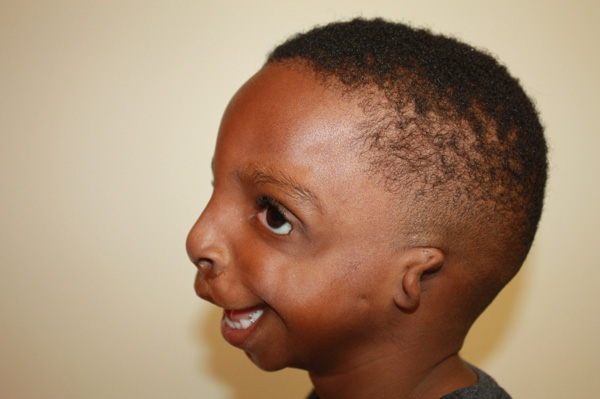Treacher Collins Syndrome
Also known as: Treacher Collins, mandibulofacial dysostosis
What is Treacher Collins?
Treacher Collins is a genetic disorder that impacts how the face develops. Specifically, it can cause abnormal development of the jaws, ears, eyelids and cheekbones.
Dr. Edward Treacher Collins described two patients with features of this condition in 1900. Additional description of the condition was made by Dr. Adolphe Franceschetti and Dr. David Klein. They called the condition mandibulofacial dysostosis (abnormal bone formation of the face).
What are the symptoms of Treacher Collins?
The primary clinical signs of Treacher Collins syndrome are:
- Down-slanting eyes
- Coloboma (defect) of the lower eyelid
- Some missing eyelashes on the lower eyelid
- Underdevelopment of the bones in the upper and lower jaw and bone under the eyes (zygoma)
- Ear anomalies (external and internal)
- Normal intelligence

What causes Treacher Collins?
Most cases of Treacher Collins are caused by a change (mutation) in a gene call the TCOF gene. A smaller number of patients have been found to have mutations in the POLR1D and POLR1C genes.
When individuals are found to have a mutation in the TCOF or POLR1D genes, Treacher Collins is inherited in an autosomal dominant pattern. For these individuals, only one copy of the gene (TCOF or POLR1D) has to have a mutation in order for the person to show clinical features of the condition. With this type of inheritance, affected individuals have a 50% risk for having children with Treacher Collins Syndrome. However, unaffected parents of a child affected with Treacher Collins that is inherited in an autosomal dominant pattern have a low risk of having other children with the condition.
When affected individuals are found to have a mutation in the POLR1C gene, Treacher Collins in inherited in an autosomal recessive pattern. When this happens, both parents of an affected child do not show any clinical features of the condition, but are carriers for a mutation in the POLR1C gene. If both parents pass down a copy of the POLR1C gene that has a mutation to a child, the child will have a mutation in both copies of the POLR1C gene and be affected with Treacher Collins. In this case, the parents of an affected child have a 25% risk in each of pregnancy for having an affected child. However, the person affected with Treacher Collins caused by a mutation in the POLR1C gene will have a low risk for having children with the condition unless their reproductive partner is related to them in some way.
Genetic testing is available. Therefore, to accurately determine whether future siblings/offspring may be affected clinical genetics evaluation and counseling are recommend for all families.
What are Treacher Collins care options?
There is no cure for Treacher Collins syndrome. The individual symptoms can be treated as they occur in order to give individuals with the disease the best quality of life possible. With close medical attention, the prognosis for most children with this condition is positive. Multiple surgeries and ongoing therapies are often required for these children but most will ultimately attend school, have friends, and most of all enjoy life.
With close follow-up by a craniofacial team, these children can grow to be healthy and happy adults. The Craniofacial team at Nicklaus Children’s Hospital has a large experience in treating patients with Treacher Collins Syndrome. Care is individualized for each child to maximize aesthetic and functional outcomes.
Reviewed by: Chad A Perlyn, MD
This page was last updated on: February 06, 2020 03:20 PM
Related Videos
Dr. Chad Perlyn is a pediatric plastic surgeon specializing in craniofacial surgery.